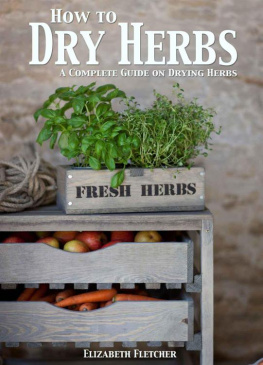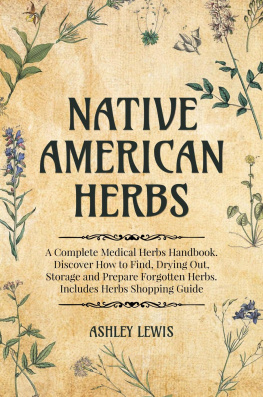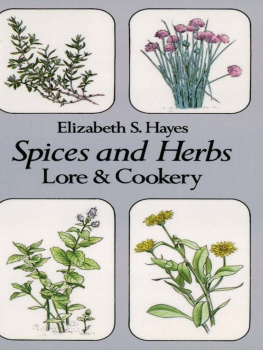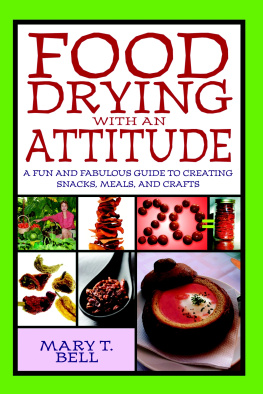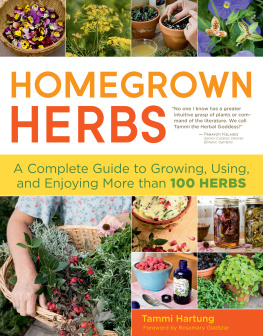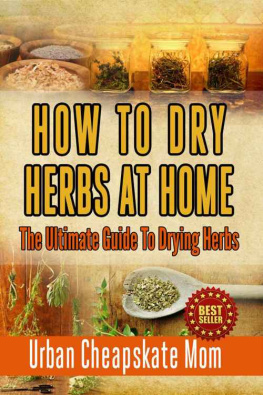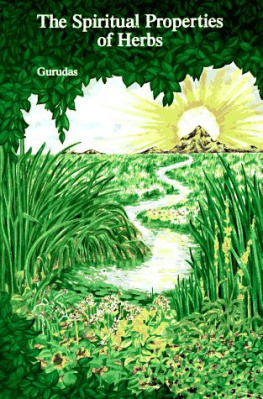Elizabeth Fletcher - How to Dry Herbs: A Complete Guide on Drying Herbs
Here you can read online Elizabeth Fletcher - How to Dry Herbs: A Complete Guide on Drying Herbs full text of the book (entire story) in english for free. Download pdf and epub, get meaning, cover and reviews about this ebook. year: 2014, genre: Home and family. Description of the work, (preface) as well as reviews are available. Best literature library LitArk.com created for fans of good reading and offers a wide selection of genres:
Romance novel
Science fiction
Adventure
Detective
Science
History
Home and family
Prose
Art
Politics
Computer
Non-fiction
Religion
Business
Children
Humor
Choose a favorite category and find really read worthwhile books. Enjoy immersion in the world of imagination, feel the emotions of the characters or learn something new for yourself, make an fascinating discovery.
- Book:How to Dry Herbs: A Complete Guide on Drying Herbs
- Author:
- Genre:
- Year:2014
- Rating:4 / 5
- Favourites:Add to favourites
- Your mark:
- 80
- 1
- 2
- 3
- 4
- 5
How to Dry Herbs: A Complete Guide on Drying Herbs: summary, description and annotation
We offer to read an annotation, description, summary or preface (depends on what the author of the book "How to Dry Herbs: A Complete Guide on Drying Herbs" wrote himself). If you haven't found the necessary information about the book — write in the comments, we will try to find it.
How to Dry Herbs: A Complete Guide on Drying Herbs — read online for free the complete book (whole text) full work
Below is the text of the book, divided by pages. System saving the place of the last page read, allows you to conveniently read the book "How to Dry Herbs: A Complete Guide on Drying Herbs" online for free, without having to search again every time where you left off. Put a bookmark, and you can go to the page where you finished reading at any time.
Font size:
Interval:
Bookmark:
How to Dry Herbs
A Complete Guide on Drying Herbs
Elizabeth Fletcher
Copyright 2014 by Elizabeth Fletcher
All rights reserved. No part of this publication may be reproduced, distributed, or transmitted in any form or by any means, including photocopying, recording, or other electronic or mechanical methods, without the prior written permission of the publisher, except in the case of brief quotations embodied in critical reviews and certain other noncommercial uses permitted by copyright law.
Drying herbs is a rather simple process that is used to preserve herbs and make them last for a longer period of time. The effectiveness and method with which an herb can be dried will depend on many factors, including the type of herb and the time at which the fresh leaves or flowers were harvested.
Not all types of herbs will dry in the same conditions and in the same amount of time. This is one exciting part about this: you get to do trial and error and by experience alone you will become an expert in knowing what is the amount of time required for certain types of herbs to dry.
The main trick in drying herbs effectively lies on the ability of drying out all the water to prevent molding while maintaining the herbs natural oils and flavors. But you will find out that with time, you will become more and more familiar with the most effective methods for drying your own garden herbs.
A basic knowledge on what the different types of herbs are and their culinary or crafting importance goes a long way on effectively drying herbs for preservation. You must be aware of the weather, types of leaves, the thickness of the stem, even the presence of bugs in the garden. All these elements combined will make of you the best herb drier.
I created a complete guide into herb drying. It contains comprehensive descriptions of the types of herbs you can dry and the best ways of doing so. It also contains comments about why it is important to dry herbs and how to store them afterwards. This is a must read before you plan on drying herbs on a regular basis.
So, either for culinary or medicinal purposes, or for decoration or crafting, choosing the right technique for drying every different type of herb will provide great success in obtaining perfectly dried herbs.
What is Herb Drying ?
Preserving food for later consumption has always been a concern to cooks and different methods have been devised for different types of foods. Of all these methods, drying herbs is the easiest one and one that can be easily done at home. Drying herbs at home is actually a very smart choice since dried herbs at the store can become rather costly. A great thing about drying herbs is that the methods used to do so are very simple yet very effective.
When herbs are dried, all moisture is removed and plants become impervious to yeast, mold, and bacteria without significantly losing their natural oils and nutritional properties. After the process of drying is completed, the plants can be perfectly preserved for six to twelve months.
To remove moisture from herbs, all you need is some air. Yet you need to be smart by simply drying them with the sun you can cause all their natural oils to be burned away which, of course, is an undesired result.
Herbs can be obtained at any groceries store or they can be harvested at your own garden. These need to be washed to remove any dirt or remains from other animals. Given that you bought them in a store, there is no way for you to know what they have been exposed to. If the plants have been grown organically, probably they do not need washing. Best thing is to grow them in your own backyard. They might still need some washing. The washing process should be done carefully trying not to tear the leaves of the plant.
Either for consumption or for ornamental purposes, drying herbs will effectively remove moisture from the plant. Luckily, herbs contain so little moisture that they will remain practically untouched after they have been dried. Several methods that guarantee the sole removal of moisture have been devised. They vary in types of instruments required and time for results. We will be thoroughly discussing each one of these methods as well as what are the best types for specific types of plants.
There are usually three basic purposes for drying herbs.
For food preservation.- Herbs filled with moisture are very prone to mold, yeast, and bacteria. These have the detrimental action of degrading plants and withering them fast. Removing the moisture guarantees that these pathogens do not infect the plant and are apt for human consumption.
For medication.- The procedure is basically the same for medicinal purposes. Herbs such as basil and lavender fall into this category.
For decoration.- Herbs that are for decorative purposes only can be dried out with certain methods that involve chemical substances that would be otherwise harmful for human consumption. Lavender is a widely used dried herb for decorative purpose, along with many other. We will get into more details later.
The main factor needed to dry herbs is a drying agent that is not excessive sun exposure or any other source of strong light. This is because if heat is too intense, it will affect the nutritional content of the herb along with the pleasant oils. Overexposing an herb to direct sunlight will cause it to bleach. The factors or instruments that can be used to do this are the wind, a paper press, an oven (carefully heated), a desiccant such as silica, or a microwave oven.
The most widely used method for drying herbs consists on placing them into a bundle and hanging them upside down to allow the wind to dry them. They are usually placed inside a paper bag. The downside of this method is that it takes some time for the herbs to dry; namely a week or so-it ultimately depends on the type of herb being dried.
As expressed before, the drying method applied to herbs will vary depending on the type of plant. The main reason for this is the strength of the leaves and oil content. The amount of time that an herb must be dried and how to best dry it without compromising flavor and oil content will be determined by you through trial and error until you become an expert. But this guide is a great start into it. Some leaves are really sturdy and will retain their color even after drying. On the other hand, leaves such as mint, parsley, or lemon balm, need to be dried before they quickly catch mold.
Some general things to remember if you are harvesting your own herbs would be: Experts recommend you to harvest an herb right before it flowers, but if you want to dry along with the flowers, you can perfectly do so after they bloom. Or you can experiment with both and see which one provides you with more satisfying results. Cut them in the morning, right after all the dew has evaporated from the morning sun. Make sure to wash them thoroughly but carefully and dry them gently to prevent them from breaking or getting damaged. Once you have washed them and removed the water, you must immediately proceed to the drying process. The following are the most common methods used for drying herbs.
This is not really a method for having dried herbs but instead it refers to drying them and having them fresh right before cooking. So, this will usually take approximately an hour.
Basically, place a towel or cloth on some rack, maybe the dish rack. Lay your herbs over this towel without overlapping them. Keep them within the warmth of your kitchen. After an hour or so, you should go ahead and check if herbs are dry enough for cooking.
Font size:
Interval:
Bookmark:
Similar books «How to Dry Herbs: A Complete Guide on Drying Herbs»
Look at similar books to How to Dry Herbs: A Complete Guide on Drying Herbs. We have selected literature similar in name and meaning in the hope of providing readers with more options to find new, interesting, not yet read works.
Discussion, reviews of the book How to Dry Herbs: A Complete Guide on Drying Herbs and just readers' own opinions. Leave your comments, write what you think about the work, its meaning or the main characters. Specify what exactly you liked and what you didn't like, and why you think so.

